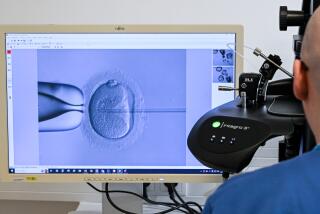Test-Tube Babies and Designer Genes
- Share via
Louise Brown, the world’s first test-tube baby, turns 25 today, and it certainly seems like a reason to celebrate. Brown is by all accounts a healthy, normal young woman, and her birth opened the door for a million or so childless couples worldwide to fulfill their dreams of having a family.
But once the final chorus of “Happy Birthday” fades, we should take a hard look at in vitro fertilization and the fertility business it has spawned. It’s not just a matter of helping the hopeless, it’s also about the dubious claims of a for-profit industry -- that it can ensure healthier babies, that we can do a better job than nature when it comes to engineering life.
For starters, we need to remember that IVF pioneers -- including British researcher Robert Edwards and physician Patrick Steptoe, who crafted the embryo that became Louise Brown -- were essentially running human experiments, with little oversight, on a vulnerable patient population.
Although so far most IVF babies seem normal -- that is, they have medical problems in about the same numbers as the rest of us -- concerns persist about the true effects of having been conceived in the lab.
The population isn’t large enough or old enough to have yielded a complete picture. In fact, several recent studies marked increases in birth defects and eye cancers among IVF children, and several studies have indicated that babies conceived by a sperm injection technique known as ICSI may be at higher risk for some genetic ailments.
It remains anyone’s guess whether other susceptibilities may begin to show up in IVF offspring in adulthood.
Questions also remain about the long-term cancer risks of the hormones used to stimulate egg production in women undergoing IVF or serving as egg donors. Multiple births -- heavily associated with increased genetic and developmental risks -- have skyrocketed because, to increase the chances of a pregnancy, multiple embryos are transferred from petri dish to womb.
But more worrisome is that IVF clinics now want to convince fertile couples that they should use their services.
The first step is to persuade them that the kinds of genetic screening now done on fetuses should really be done on embryos -- this way, couples can avoid the difficult decision of whether or not to abort when amniocentesis reveals Tay-Sachs, Down syndrome or other “negative” traits.
The next step is to select for so-called positive traits. Promoters of the designer-baby enterprise, including such luminaries as Nobel laureate James Watson, say that in the future, the number of traits that can be selected will be manifold, thanks to the fruits of the Human Genome Project.
The fact is, reproductive research’s goal has long been to “improve” babies. Edwards wrote enthusiastically about the merits of such tinkering well before Brown’s birth.
But this new eugenics is problematic on both scientific and ethical grounds. Centuries of conventional breeding and recent gene-modification experiments with animals have revealed that genetics is extraordinarily complex, and that even replacing or deleting a single gene can have unforeseen consequences.
Such meddling is beyond reproductive science’s powers now, but the precursor isn’t. We could, for example, select an embryo that has inherited its parents’ genes for red hair and green eyes, or choose a baby’s gender.
Any such work is unsavory because it categorizes children as consumer objects that can be “accessorized” according to the parents’ whims. As many ethicists have argued, ideally, love for offspring should not be contingent upon the characteristics they possess.
Despite these disturbing implications of modern reproductive medicine, the U.S. has largely failed to engage in a substantive public discussion about the social implications of IVF. Because federal legislators are leery of political battles that involve reproductive rights, IVF physicians work mainly under guidelines set by and policed by themselves.
As a result, the U.S. lags behind other developed countries -- especially Germany, France, Britain, Australia and Canada -- in terms of oversight: We do fewer studies of IVF practices as well as apply fewer legal limits.
This means that, as long as the IVF industry has willing guinea pigs, clinics will continue to push the envelope, and researchers and their clients will set the rules that have an affect on us all.
Twenty-five years ago, early critics of IVF warned that it would create monsters. Those fears proved hyperbolic, but IVFs’ successes so far are not a protection against problems in the future.
We should undertake extensive studies, formulate public policy and join with nations worldwide to ensure that the designer-baby enterprise never truly takes off.
Gina Maranto is the author of “Quest for Perfection: The Drive to Breed Better Humans” (Scribner, 1996).






